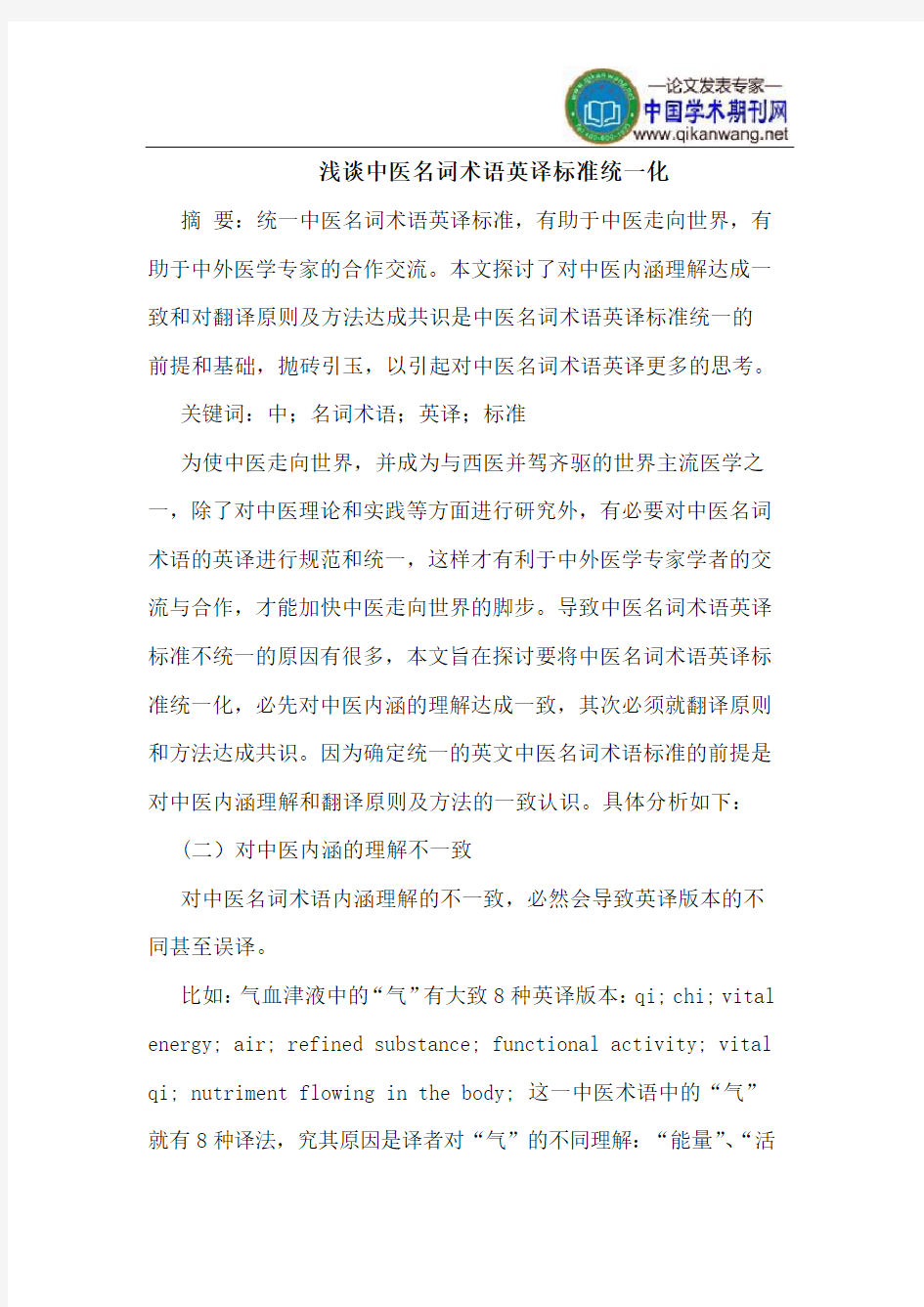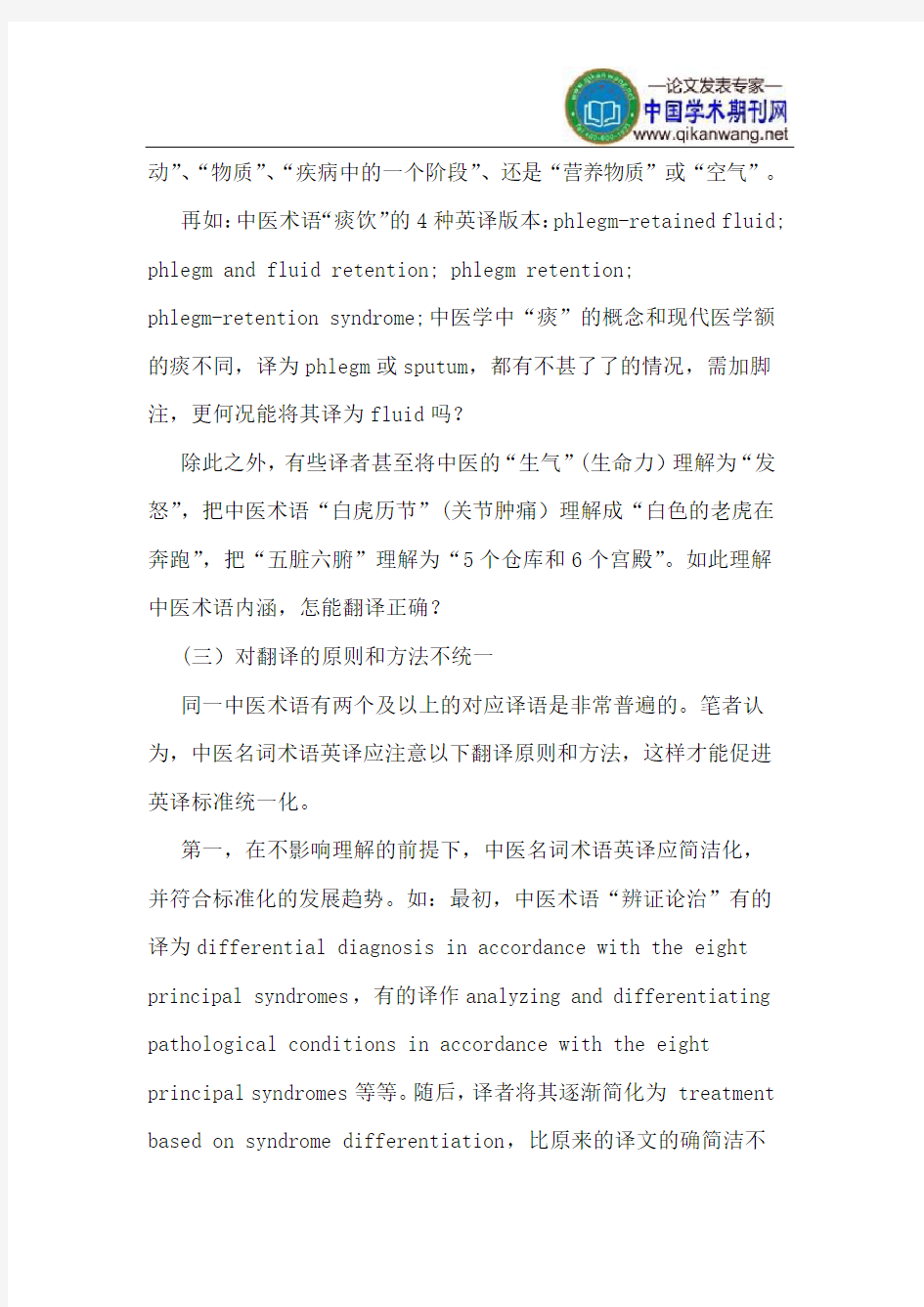中医名词术语英译标准统一化


浅谈中医名词术语英译标准统一化摘要:统一中医名词术语英译标准,有助于中医走向世界,有助于中外医学专家的合作交流。本文探讨了对中医内涵理解达成一致和对翻译原则及方法达成共识是中医名词术语英译标准统一的
前提和基础,抛砖引玉,以引起对中医名词术语英译更多的思考。
关键词:中;名词术语;英译;标准
为使中医走向世界,并成为与西医并驾齐驱的世界主流医学之一,除了对中医理论和实践等方面进行研究外,有必要对中医名词术语的英译进行规范和统一,这样才有利于中外医学专家学者的交流与合作,才能加快中医走向世界的脚步。导致中医名词术语英译标准不统一的原因有很多,本文旨在探讨要将中医名词术语英译标准统一化,必先对中医内涵的理解达成一致,其次必须就翻译原则和方法达成共识。因为确定统一的英文中医名词术语标准的前提是对中医内涵理解和翻译原则及方法的一致认识。具体分析如下:(二)对中医内涵的理解不一致
对中医名词术语内涵理解的不一致,必然会导致英译版本的不同甚至误译。
比如:气血津液中的“气”有大致8种英译版本:qi; chi; vital energy; air; refined substance; functional activity; vital qi; nutriment flowing in the body; 这一中医术语中的“气”就有8种译法,究其原因是译者对“气”的不同理解:“能量”、“活
中医术语翻译的国际标准与文化传承
中医术语翻译的国际标准与文化传承 近期,千华翻译公司翻译了一批中医文献,现将我们搜集的部分有用的资料共享如下: 2007年1O月,世界卫生组织(WH0)西太区颁布了《传统医学名词术语国际标准》(WHO International StandardTerminologies 011 Traditional Medicine in the Western PacificRegion)。这一标准的颁布,使得中医术语翻译的规范化进程向前迈出了坚实的一步。同时,这一标准也将有助于包括中医学在内的传统医学在世界范围内的推广和应用,因此被业内人士称为“传统医学发展的里程碑”。然而,从学科自身发展角度而言,这一新的国际术语标准并非一成不变,WHO有关官员表示在今后实践中将对此标准不断修改与完善,使术语的翻译能更准确地将中医文化体现出来。现从经络部分就中医术语的翻译和文化传承进行粗浅探索。 1 WH0西太区颁布的《传统医学名词术语国际标准》经络部分的翻译和文化传承 1.1 十二经脉的翻译与文化传承:十二经脉是结合脏腑、手足、阴阳三方面内容而命名的。WH0西太区颁布的《传统医学名词术语国际标准》中,将十二经脉的翻译如下:手太阴肺经:lung meridian(LU);手阳明大肠经:large intestinemeridian(LI);足阳明胃经:stomachmeridian(ST);足太阴脾经:spleenmeridian(SP);手少阴心经:heartmeridian(HT);手太阳小肠经:small intestine meridian(SI);足太阳膀胱经:bladdermeridian(BL);足少阴。肾经:kidlleymeridian(KI);手厥阴心包经:pericardium meridian(PC);手少阳三焦经:triple energizer meridian(TE);足少阳胆经:gallbladder meridian(GB);足厥阴肝经:liver meridian(LR)。从上述翻译中可以看到,WH0西太区在翻译这些术语时,主要是由“脏腑名称”+“经脉名”构成。这种方法简便、方便交流,但这样翻译明显有遗漏。如“lung meridian(LU)”的翻译中,看不到“手太阴”的翻译。《灵枢·经脉》中对十二经脉的命名采用“脏/腑+手/足+阴/阳+脉”的形式命名。该命名形式,主要是在继承和保留“手/足+阴/阳+脉”格式的基础上,将脏腑名置于手足阴阳之前,增加了脏腑的元素,体现了经脉理论和脏腑理论的融合。所以,我们看到每一经脉的名称均依据分布于手足内外、所属脏器的名称和阴阳属性命名。为了准确、毫无遗漏的传递这些术语信息,笔者建议应以“脏或腑+经脉名称+of+手或者足+阴阳”的格式翻译,具体如下:手太阴肺经:lung meridian ofhand.taiyin(LU);手阳明大肠经:large intestine meridian ofhand.yangming(LI):足阳明胃经:stomach meridian offoot.yangming(ST);足太阴脾经:spleen meridian of foot.taiyin(SP);手少阴心经:heartmeridian ofhand.shaoyin(HT):手太阳小肠经:small intestinemeridian ofhand.taiyang(SI);足太阳膀胱经:bladder meridianof foot.taiyang(BL):足少阴肾经:kidney meridian offoot.shaoyin(KI);手厥阴心包经:pericardium meridian ofhand-jueyin(PC);手少阳三焦经:sanjiao meridian ofhand.shaoyang(SJ);足少阳胆经:gallbladder meridian offood—shaoyang(GB):足厥阴肝经:livermeridian offood-jueyin(LR)。采用这样的格式英译十二经脉名,能够完整体现中医对十二经脉命名的全部信息。 另外,三焦的英译也与中医理论和传统文化不合。WHO西太区在《传统医学名词术语国际标准》将“手少阳三焦经”译为“triple energizer meridian(TE)’这里涉及一个很具有中医文化特色的术语“三焦”的翻译。三焦是一个特殊的“腑”,既是对人体胸腹部位及其所藏脏腑器官目的划分,又是对人体某些功能系统的概括。三焦分上、中、下三焦,主要
中译英
1.我们大家深受感动,结果把所有的零用钱都给了那个穷男孩。 We were all so moved that we gave all our pocket money to the poor boy. 2.他们夜以继日地工作,为了能按时修建起这座大桥。 They worked day and night so that they could build the bridge on time. 3.我认为买一本大的英汉词典很有必要。 I think it necessary to buy a big English-Chinese dictionary. 4.他的话听起来很合理,但是我们不知道他是否说了实话。 What he said sounded reasonable, but we wondered if he had really told the truth. 5.我们宁可步行也不愿意挤乘这么拥挤的公共汽车去学校。 We would rather go to school on foot than push our way into the crowded buses. 6.他说什么并没有关系,重要的是他怎么干。 It doesn't matter what he says. What is important is how he works. 7.碰巧我带着一张上海地图,因此没有迷路。 It so happened that I had a map of Shanghai with me, so I didn't get lost. 8这己不是我第一次来上海了。我第一次来上海时对所见所闻都觉得有趣。 It's not the first time that I have visited Shanghai. When I came for the first time, everything I saw and heard seemed interesting to me 9.除非你说实话,否刚你不会得到我们的帮助。 You won't get our help Unless you tell us the truth. 10.你打个电话给她,她马上就会把你所需要的东西送来的。 Call her and she will immediately bring you what you need. 11.像那样谈论是没有用的。我们必须制定一个计划,然后加以实施。 It's no use talking like that. We must make a plan and realize it. 12.你真好,提醒了我有个重要的会议。 It's so kind of you to remind me of the important meeting. 13.当我们听到他被选为队长的消息,我们禁不住欢呼起来。 We couldn't help cheering up when we learned the news that he had been made captain. 14.如果有必要,我会请人把剩下的票都买下来。 If necessary, I'll have the remaining tickets bought
浅谈中医术语“六淫”的英译
浅谈中医术语“六淫”的英译 Abstract Traditional Chinese Medicine is Chinese excellent traditional culture important component, is rich in content, the thought is profound, has an independent theoretical system.Traditional Chinese Medicine should face the world, face future, face modernization. English translation of Traditional Chinese Medicine is the key. The English translation of Traditional Chinese Medicine involves multiple specific discipline and many aspects of other disciplines. The English translation of Chinese Medicine Terminology, especially is the key. TCM term is the most basic concepts of Traditional Chinese Medicine, connotation is rich, the implication is profound. The English translation of scientific or not, relates to the international exchange of Traditional Chinese Medicine, in relation to the future of the Traditional Chinese Medicine. We in the translation of TCM terms, must follow the certain translation principles.The author believes that the translation of TCM terms shall adhere to the principle of "five characters", i.e., the scientific principle, the principle of information, normative principles, to accept the principle, cultural principle. The "six excesses " of the translation, must be based on basic theories of TCM, to understand "six excesses" of the sequence of events, in order to make the translation of scientific norms of acceptable. In the English translation of Traditional Chinese Medicine, to stringent attitude, not only requires the accurate expression of the content of traditional Chinese medicine, but also to meet the English language inherent laws, in line with the English expression, pay attention to English style, style, flexible, not dogma.While paying attention to the characteristics of Traditional Chinese Medicine, concise, practical, custom and convention. Key words: Nomenclature of Traditional Chinese Medicine; International exchange;English translation principles; Excesses of the six factors 1前言 中医药学是一个伟大的宝库,是世界医学的重要组成部分。随着医药卫生的对外交流,中医药的临床疗效和理论体系已越来越引起国际上的重视,中医药的国际交流日趋频繁。为了
中医常用词汇英文翻译
中医常用词汇英文翻译01
中医英语常用词汇英文翻译02 气化不利dysfunction of qi in transformation 畏寒喜热aversion to cold and preference for heat 气分热盛excessive heat at qi phase
气郁化热stagnation of qi transforming into heat 温养脏腑warming and nourishing the viscera 瘀血阻络blood stasis obstructing the collaterals 清肺润燥clearing the lung and moistening dryness 破瘀通经breaking blood stasis to promote menstruation 内伤头疼headache due to internal injury 祛瘀eliminating stasis, expelling stasis 逆传心包reverse transmission into the pericardium 气不摄血failure of qi to check the blood 宁心安神calming the heart and tranquilizing the mind 血液循行circulation of the blood 惊悸不安palpitation due to fright 气的运动形式the moving styles of qi 血液生成不足insufficient production of the blood 平肝止血soothing the liver to stop bleeding
最全中医术语英文大全
[学科] 中医①traditional Chinese medicine②traditional Chinese physician ①中医学的简称。 ②本学科专业职业队伍。 中药Chinese materia medica 在中医理论指导下应用的药物。包括中药材、中药饮片和中成药等。 中医学traditional Chinese medicine 以中医药理论与实践经验为主体,研究人类生命活动中健康与疾病转化规律及其预防、诊断、治疗、康复和保健的综合性科学。 中药学Chinese materia medica 中药学科的统称。研究中药基本理论和各种药材饮片、中成药的来源、采制、性能、功效、临床应用等知识的学科。 中医药traditional Chinese medicine and pharmacology 本草:Materia medica 中药:Chinese materia medica,Chinese medicinals(包括植物药、动物药、矿物药等) 中草药:Chinese Herbal Medicine,Chinese medicinal herbs 中药学:Chinese pharmaceutics 药材:Medicinal substance(material) 中西医结合integration of traditional and western medicine 中医基础理论basic theory of traditional Chinese medicine 中医诊断学diagnostics of traditional Chinese medicine 方剂学 prescriptions of Chinese materia medica, Traditional Chinese Medical Formulae/ prescriptions 中医内科学internal medicine of traditional Chinese medicine [阴阳]The Theory of Yin and Yang 阴阳对立:Opposition of yin and yang 阴阳制约:Restriction of /between yin and yang 阴阳互根:Interdependence of yin and yang 阴阳消长:Waxing and waning of yin and yang 阴阳转化:Inter-transformation of yin and yang [五行学说]The Theory of Five Elements 五行:water,fire,wood,metal,soil 生:promote, generate, engender 克:act, restrict, restrain 乘:overact, over-restrict, over-restrain, subjugate, overwhelm 侮:counteract, counter-restrict, counter-restrain, rebel [整体观念] concept of organic wholeness 辩证法dialectics 生长化收藏sprouting, growth,transformation,ripening,storage 内外环境统一性the unity between the internal and external environments 机体自身整体性the integrity of the body itself 古代唯物论和辩证法classic Chinese materialism and dialectics 矛盾统一the contradictory unity 互相联系、相互影响related to each other and influence each other
中医英语词汇汇总.doc
v1.0可编辑可修改Lesson One History of Traditional Chinese Medicine 中医术语 acupunture and moxibusion 针灸 health maintenance 养生 drugs cold and cool 寒凉药 the school of cold and cool 寒凉派 diaphoesis emesis purgation 汗吐下 the school of purgation 攻下派 exagenous pathogenic factors 外邪 reinforcing the earth 补土 internal impairment of spleen and stomach would bring about vorious diseases 内伤脾胃百病由生 yang is usually redundant ,while yin is frequently deficient. 阳常有余阴常不足 nourishing yin滋阴 medicinal herbs草药 blood stagnation淤血 warm and inorgorate the spleen and stomach温养脾胃 中国医药学 : traditional Chinese medicine 中医基础理论 : basic theory of traditional Chinese medicine 临床经验 : clinical experience 辨证论治 : treatment based on syndrome differentiation;pattern identification and treatment 本草 : materia medica 中药 : Chinese materia medica; Chinese medicinals 中草药 : Chinese medicinal herbs 四气五味 : four properties and five tastes
中医术语英文翻译对照表
中医术语英文翻译对照表 治则在对临床的具体立法、处方、用药等具有普遍的指导意义,因而在治疗疾病时必须遵循的基本原则。 治病求本针对产生疾病的根本原因进行治疗的原则。 急则治标与缓则治本相对而言,在大出血、暴泻、剧痛等标症甚急的情况,及时救治标病 缓则治本与急则治标相对而言,针对病势缓和、病情缓慢的情况,从本病的病机出发,采取调理、补益为主的治疗原则。标本兼治针对病证出现的标本并重的情况,采用治标与治本相结合的治疗原则。 治未病采取一定的措施防止疾病产生和发展的治疗原则,包括未病先防和既病防变两个方面。 同病异治表现相同的病证,可因人、因时、因地的不同,或由于病情的发展、病机的变化、病型的各异、正邪消长等差异,采取不同治法的治疗原则。 异病同治表现不同的病证,由于发病机理相同,采取相同治法的治疗原则。 因时制宜考虑到时令气候寒热燥湿的不同而选择适宜的治法、方药的治疗原则。 因地制宜考虑到地域环境的不同而选择适宜的治法、方药的治疗原则。 因人制宜 's 考虑到病人的体质、性别、年龄、生活习惯
以及过去病史等个体差异性的不同而选择适宜的治法、方药的治疗原则。 扶正祛邪对于正虚为主、因虚致实的病证,应采取扶助正气为主,使正气加强,从而达到驱除病邪目的的治疗原则。 祛邪扶正对于邪气实而正气偏虚的病证,应采用以消除病邪为主,扶助正气为辅,使邪去正安或正复的治疗原则。 扶正固本对于正气亏虚的病证,采用培补正气以愈病的治疗原则。 攻补兼施对于虚实夹杂,或虚实病情相当,可采用既祛邪又培补,即攻邪与扶正并重的治疗原则。 正治法又称“逆治法”。 针对疾病的本质,从正面进行治疗,即逆病性而治的常规方法。寒者热之针对寒性的病证应使用温热方药进行治疗的 原则。 热者寒之针对热性的病证应使用寒凉方药进行治疗的 原则。 虚者补之又称“虚则补之”。 针对虚弱性的病证应采用补益方药进行治疗的原则。 实者泻之又称“实则泻之”。 针对性质属实的病证应采用攻泻方药进行治疗的原则。 反治法又称“从治法”。 针对疾病出现假象,或大寒证、大热证用正治法发生格拒的情况,
中医英语术语
第一课 1.中国中医药traditional Chinese medicine; TCM 中医基础理论basic theory of traditional Chinese medicine 临床经验clinical experience辨证论治treatment based on syndrome differentiation 杂病miscellaneous diseases中药学Chinese pharmacy 四气五味four properties and five tastes 针灸acupuncture and moxibustion; acumox古代中国哲学classical Chinese philosophy汗法sweating therapy; diaphoresis 下法purgation吐法vomiting therapy; emetic therapy补土派the School of Reinforcing the Earth方剂prescription; formula 医疗实践medical practice治疗原则therapeutic principles寒凉药herbs cold and cool in nature滋阴降火nourishing yin and reducing fire瘀血致病diseases caused by blood stagnation 第二课 1 ve zang-organs; five zang-viscera五脏six fu-organs六腑system of meridians and collaterals经络系统holism整体观念organic wholenss有机整体social attribute社会属性(of the five zang-organs) open into开窍sprout, grow, transform, ripen and store生长化收藏diagnostics诊断学relationship between pathogenic factors and healthy qi邪正关系therapeutics治疗学common cold due to wind and cold风寒感冒different therapeutic methods used to treat the same disease同病异治the same therapeutic method used to treat different diseases异病同治balance of water metabolism水液代谢平衡clearing away heart fire清心火nature of disease疾病本质treating the left side for curing diseases located on the right side以左治右drawing yang from yin从阴引阳treating the lower part for curing diseases located on the upper part病在上者下取之 第三课 1 philosophical concept哲学概念mutual transformation相互转化balance of yin and yang阴平阳秘transformation between yin and yang阴阳转化extreme cold turning into heat寒极生热 pathological changes病理变化absolute predominance 绝对偏盛 general rule of pathogenesis病机总纲supplementing what it lacks of补其不足eliminating wind and dispersing cold祛风散寒mutually inhibiting and promoting相互消长mutually inhibiting and restraining相互制约interdependence相互依存excess of yin leading to decline of yang阴胜则阳病contrary and supplementary to each other相反相成organic whole有机整体impairment of yang involving yin阳损及阴deficiency of both yin and yang阴阳两虚deficiency cold syndrome虚寒证suppressing yang and eliminating wind熄风潜阳 第四课 1.the doctrine of five elements; the theory of five phases五行学说free development 条达舒畅to be generated and to generate生我我生restraint in generation生中有制Wood is characterized by growing freely and peripherally.木曰曲直Earth is characterized by cultivation and reaping.土元稼穑 Water is characterized by moistening and downward flowing.水曰润下over restriction and counter-restriction相乘相侮Wood over restricts earth because it is deficient.土虚木乘promotion, restriction, inhibition and transformation生克制化disorder of a mother-organ involving its child-organ母病及子insufficiency of essence and blood in the liver and kidney肝肾精血不足blood deficiency in the heart and liver心肝血虚exuberant fire in the heart心火亢盛insufficiency of liver yin肝肾不足declination of kidney yang肾阳衰微weakness of the spleen and stomach脾胃虚弱soothing the liver and harmonizing the stomach平肝和胃insufficiency of kidney yin肾阴不足balance between water and fire水火不济 第五课 doctrine of visceral manifestations脏象学说five zang-organs and six fu-organs五脏六腑extraordinary fu-organs齐桓之府nutrients of water and food水谷精微ransmitting and transforming water and food传化水谷storing essence贮藏精气internal and external relationship表里关系therapeutic effects治疗效应 clinical practice临床实践storage without discharge藏而不写discharge without storage泻而不藏physical build and various orifices形体诸窍(of five zang-organs) open into开窍spirit and emotions精神情志the heart storing spirit心藏神the lung storing corporeal soul肺藏魄the liver storing ethereal soul肝藏魂the spleen storing consciousness 脾藏意the kidney storing will肾藏志the luster manifesting upon the face其华在面 第六课 the heart governing blood and vessels心主血脉sufficiency of heart qi心气充沛rosy complexion面色红润sufficiency of blood血液充盈unsmooth vessels脉道不利lusterless complexion面色无华thin and weak pulse脉象细弱the heart storing
中医术语英文翻译对照表
中医术语英文翻译对照表 治则 principle of treatment 在对临床的具体立法、处方、用药等具有普遍的指导意义,因而在治疗疾病时必须遵循的基本原则。 治病求本 treatment aiming at its pathogenesis 针对产生疾病的根本原因进行治疗的原则。 急则治标 symptomatic treatment in acute condition 与缓则治本相对而言,在大出血、暴泻、剧痛等标症甚急的情况,及时救治标病 缓则治本 radical treatment in chronic case 与急则治标相对而言,针对病势缓和、病情缓慢的情况,从本病的病机出发,采取调理、补益为主的治疗原则。标本兼治 treating both manifestation and root cause of disease 针对病证出现的标本并重的情况,采用治标与治本相结合的治疗原则。 治未病 preventive treatment of disease 采取一定的措施防止疾病产生和发展的治疗原则,包括未病先防和既病防变两个方面。 同病异治 treating same disease with different methods 表现相同的病证,可因人、因时、因地的不同,或由于病情的发展、病机的变化、病型的各异、正邪消长等差异,采取不同治法的治疗原则。 异病同治 treating different diseases with same method 表现不同的病证,由于发病机理相同,采取相同治法的治疗原则。 因时制宜 treatment in accordance with seasonal conditions 考虑到时令气候寒热燥湿的不同而选择适宜的治法、方药的治疗原则。 因地制宜 treatment in accordance with local conditions 考虑到地域环境的不同而选择适宜的治法、方药的治疗原则。 因人制宜 treatment in accordance with the patient's individuality 考虑到病人的体质、性别、年龄、生活习惯以及过去病史等个体差异性的不同而选择适宜的治法、方药的治疗原则。 扶正祛邪 strengthening vital qi to eliminate pathogenic factor 对于正虚为主、因虚致实的病证,应采取扶助正气为主,使正气加强,从而达到驱除病邪目的的治疗原则。 祛邪扶正 eliminating pathogen and strengthening vital qi 对于邪气实而正气偏虚的病证,应采用以消除病邪为主,扶助正气为辅,使邪去正安或正复的治疗原则。 扶正固本 strengthening body resistance 对于正气亏虚的病证,采用培补正气以愈病的治疗原则。 攻补兼施 reinforcement and elimination in combination 对于虚实夹杂,或虚实病情相当,可采用既祛邪又培补,即攻邪与扶正并重的治疗原则。 正治法 orthodox treatment 又称“逆治法”。 针对疾病的本质,从正面进行治疗,即逆病性而治的常规方法。 寒者热之 treating cold syndrome with hot natured drugs 针对寒性的病证应使用温热方药进行治疗的原则。 热者寒之 treating heat syndrome with cold natured drugs 针对热性的病证应使用寒凉方药进行治疗的原则。 虚者补之 treating deficiency syndrome with tonifying method 又称“虚则补之”。
中译英翻译范文解读
中译英翻译范文 ㈠ ⑴中国作为一个发展中国家,面临着发展经济与保护环境的双重任务。我国人口众多,资源相对不足,经济规模越来越大。经济发展与资源和环境的矛盾日益突出。环境污染严重、生态状况恶化、资源耗费巨大、回收率低而导致环境破坏等问题,已成为中国经济保持可持续发展的瓶颈。 ⑵从国情出发,中国在全面推进现代化的过程中,将环境保护视为一项基本国策,将实现经济持续发展视为一项重要战略,同时在全国范围内开展污染防治工作和生态环境保护活动,同时环境恶化的状况已基本得到了控制。 ⑶实践证明,我们协调经济发展与环境保护两者之间关系的做法是行之有效的。 ⑷中国作为国际社会中的成员,在努力保护自己环境的同时,还积极参与国际环保事务,促进国际环保合作,并认真履行了国际义务。所有这些都充分表明了中国政府和人们保护全球环境的诚意和决心。 ☆翻译☆ ⑴As a developing country, China is confronted with the dual task of developing the economy and protecting the environment. As a country with a large population, relative insufficiency of natural resources and expanding economy, China suffers an increasingly significant disparity between economic development on the one hand and natural resources and the environment on the other hand. Environmental deterioration caused by severe pollution, deteriorated ecological conditions, massive consumption of resources and low reclamation has become a bottleneck against the continuous development of Chinese economy. ⑵Proceeding from its national conditions, China has, in the process of
中医英语词汇
heat 清肺热clear away lung-heat 相互制约mutual restraint, mutual restriction/interaction 湿邪犯肺pathogenic dampness invading the lung 动态平衡dynamic equilibrium 清热泻火clearing away heat and reducing fire 阴平阳秘yin and yang in equilibrium 腠理muscular interstices, striae, interstitial space 阴阳得互根互用interdependence of yin and yang 水湿停滞retention of water and dampness, water retention 相互依存interdependence 癃闭retention of urine 阴阳离绝separation of yin and yang 气血运行circulation/flow of qi and blood 相反相成opposite and supplementary to each 阴阳转化transformation between yin and yang 生理功能physiological functions 阳消阴长yang waning and yin waxing 病理变化pathological changes 阴胜则阳病predominance of yin leading to disorder of yang 临床诊断clinical diagnosis 阴胜则阳病an excess of yin leads to deficiency of yang 阳胜生外热exuberance of yang leading to exterior heat 阳胜则热predominance of yang generating heat 阳中求阴obtaining yang from yin 寒极生热extreme cold generating heat 绝对偏盛absolute predominance 热极生寒extreme heat generating cold 阳虚则寒yang deficiency leading to cold 阳损及阴impairment of yang involving yin 阴阳俱损simultaneous consumption of yin and yang 阴液不足insufficiency of yin-fluid 阴阳两虚simultaneous deficiency of both yin and yang 病机总纲general principle of pathogenesis 阳虚发热fever due to yang deficiency 病机pathomechanism, pathological mechanism 阴阳自与natural harmony between yin and yang 阴阳胜复alternative predominance of yin and yang 木乘土the wood over-restrains the earth 虚寒证deficiency-cold syndrome 木火刑金wood-fire impairs the metal 扶阳退阴strengthening yang to reduce yin 金水相生generation between the metal and water 祛风散寒expelling/eliminating wind to dispersing cold 生克制化interrelationship between generation and restriction 消导积滞promoting digestion and removing food retention 制则生化restriction ensuring generation 潜阳熄风suppressing yang to quench wind 母病及子disease of the mother-organ affecting the child-organ 五行学说theory of five elements 传变transmission of disease, progress of disease
中医术语英译
CHAPTER 1 肝阳liver yang 肝气liver qi 肝开窍于眼liver open at the eyes 肺开窍于鼻lung open at the nose 心开窍于舌heart open at the tongue 上亢ascendant hyperactivity 肝阳上亢ascendant hyperactivity of liver yang 阳盛yang exuberance 阴盛yin exuberance 阳衰yang debilitation 阴衰yin debilitation 传统医学traditional medicine 中医traditional Chinese medicine 中西医结合integration of Traditional Chinese and Western medicine 阴阳学说yin-yang theory 五行学说five-phase theory 中医基础理论basic theory of TCM 中医诊断学traditional Chinese diagnostics 方剂学formula study 经方classified formula 合方combined formula
改方modified formula 经络学说meridian and collateral (study) 经脉meridian vessel 穴位acupuncture points 头皮针scalp acupuncture 耳针auricular acupuncture 中药学traditional Chinese pharmacy 中医养生traditional Chinese life nurturing 中医康复traditional Chinese rehabilitation 中医护理traditional Chinese nursing 整体观念holism 五脏five viscera 六腑six bowels CHAPTER 2 精气学说essential qi theory 肾精kidney essence 清气clear qi 清阳clear yang 清热clear heat 阳虚yang deficiency 虚火deficiency fire 血逆blood counterflow
